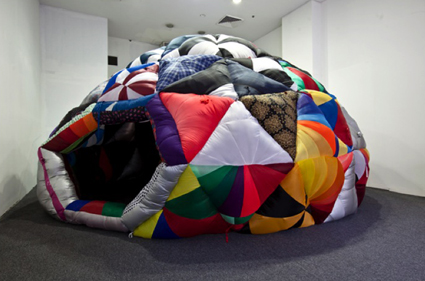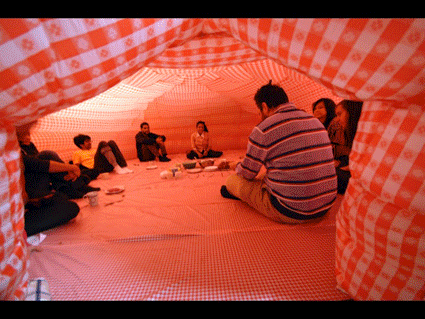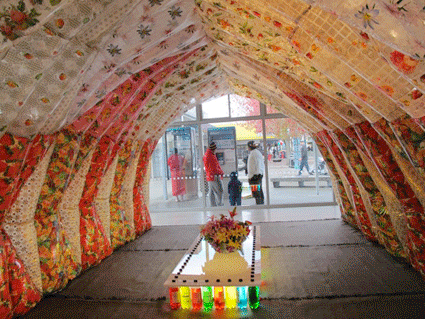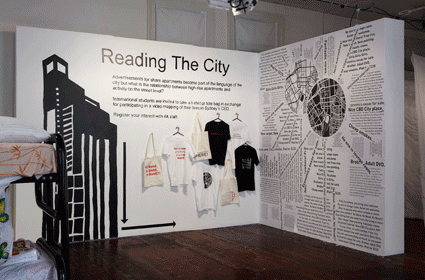In Profile: Keg de Souza
Gail Priest

Impossible Utopia 2011, Keg de Souza
Keg de Souza describes herself as an “anarchitect,” an amalgam that comes closest to encapsulating her practice which involves architecture, environmental design and activism with a little bit of drawing, printing and bookbinding included for good measure. While her artworks take varied forms her central focus is on “spatial politics… not only the built environment, but the social space inhabited within” (Artist statement). De Souza is currently one of the 2013/2014 Early Career Creative Australia Fellows and as the projects below indicate, she’s making the most of it.
Space making
De Souza came on the scene in around 2000 when she was part of Squat Space, a collective running a gallery in one of the shopfronts of Sydney’s Broadway Squats. The inhabitants were receiving a lot of attention due to their organized and highly articulate battle to legitimise their tenancy. After they were evicted, the collective continued as a roving ARI producing a number projects including SquatFest, an underground alternative to TropFest, and Tour of Beauty, a bicycle and walking tour around Waterloo-Redfern talking with locals about the area (http://squatfest.com/history/).

Gonflables et amuse-bouches 2012, Keg de Souza
courtesy the artist
Gonflables et amuse-bouches 2012, Keg de Souza
Inflatables & edibles
This interest in space and community building has recently manifested in the form of large inflatable structures. De Souza says, “Inflatables were just naturally a way for me to be able to make something that was easily transportable. I was also thinking about utopias and nomadic architecture and the history of inflatables. They were often used as a symbol of radical architecture. There was a big show in Paris in 1968 by the Utopie group that showcased a lot of work by artists, architects and activists who used inflatables in their practice, such as Ant Farm and Haus Rucker Co. But also I was thinking about what they can encompass [now] with their temporality.”
In 2012 de Souza undertook a residency at the Darling Foundry in Montreal where she created the work Gonflables et amuse-bouches which incorporated elements of food and mapping. She says, “In Montreal I was pretty taken aback by these radical activist kitchens that worked out of the two main Anglophone universities there—McGill and Concordia. These radical kitchens cook for the students everyday but they also cater for activist events…The inflatable was constructed out of disposable plastic tablecloths and I had a series of events inside it [and outside while it was being constructed] that explored food and the way it intersects with art, architecture, radical spaces and radical organising. I guess it was a way to encompass all these interests—[to see] how they can intersect and create this dialogue about communities.”

Tropical Thunder 2013, Keg de Souza
courtesy the artists
Tropical Thunder 2013, Keg de Souza
Local mapping
De Souza has continued this line of thinking in Tropical Thunder, part of the 2013 Auckland Triennial. She was based at Fresh Gallery, Otara in south Auckland, a suburb with a 70% Pasifika population: “Everything in that town centre was geared towards a Pasifika community. So out the front of supermarkets they had coconuts, green bananas and taro for sale…This continued into the $2 shop. In the $2 shop in Redfern you might see plastic flowers—sunflowers or roses—but in Otara there were frangipanis and hibiscus. Everything was tropical including material that had Pasifika patterns. But it was all made in China. I thought it was really interesting how this culture had been commodified and commercialised overseas, then all these mass-produced items from China were sold back to the culture that they were appropriated from.”
In Otara, de Souza made her inflatable out of Pasifika themed plastic tablecloths following the design of the canopy that arches over the town centre. She held sessions inside the structure with local community members and created a food-centric map of the area: “I gathered additions and comments to this map about what the locals wanted to say about food, whether it be a place to eat or a personal story, or [particular] legislations…So this created a local knowledge food map of the area.”
I asked de Souza about finding a balance between artistic and social outcomes. She is emphatic: “I’m always really clear when I do these socially driven projects that I am an artist. And I’m really clear about what I’m exploring to begin with. [But] there’s a lot of risk taking. You can’t go into a community expecting a particular outcome… [it’s only] when you meet the people—that’s what really shapes the project.”

ruangrupa ArtLab and Keg de Souza, Vertical Villages, Haymarket (2013) (installation view, 4A Centre for Contemporary Asian Art, Sydney). Commissioned by 4A Centre for Contemporary Asian Art.
courtesy 4A and the artists, photo Zan Wimberley
ruangrupa ArtLab and Keg de Souza, Vertical Villages, Haymarket (2013) (installation view, 4A Centre for Contemporary Asian Art, Sydney). Commissioned by 4A Centre for Contemporary Asian Art.
Collaborative cultures
De Souza’s most recent project, Vertical Villages, facilitated by Sydney’s 4A Centre for Contemporary Asian Art, is a collaboration with Indonesian artist collective ruangrupa ArtLab. Together they have been consulting the international student population of the CBD, exploring their micro-culture of self-organisation and redesign of urban living spaces. These students often live in city apartments with multiple occupants in the one room, creating a little slice of private domestic space out of a bunk bed with a shower curtain for privacy. The exhibition, currently still running, combines an installation of these compact living spaces complete with domestic clutter of food stashes, toiletries and TV screens showing videos made by students. There’s also a large map in which students are invited to add their own comments and suggestions for exploring the city. Students have also been invited to program House Parties—Friday night activities in the gallery.
De Souza says of this collaborative process, “I guess our practices have a lot of crossover in terms of themes—cities and space. Obviously our outcomes are really different and our aesthetics, but those processes of dialogue and gathering information [are similar]. With the outcomes here we were pushing each other to do things slightly differently. I don’t look at the show and go this is definitely ruangrupa, this is me—maybe in aesthetics—but in the process all those things were really driven together.”
Part two of Vertical Villages will see Keg de Souza joining ruangrupa in Jakarta where they will work with local migrant worker communities with the outcome exhibited as part of 15th Jakarta Biennale.






